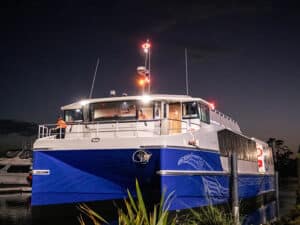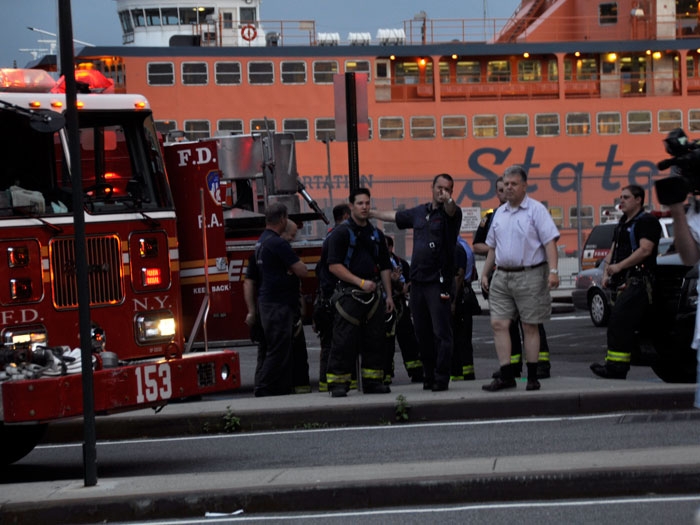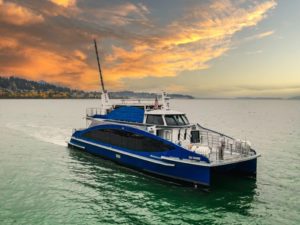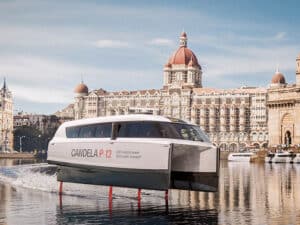
Newspaper story questions SI Ferry safety
Written by Nick Blenkey
First responders from the local fire department, Emergency Medical Service and New York City Police department of Staten Island confer about a Staten Island Ferry which allided with the dock at the St. George Staten Island Ferry Terminal on Staten Island, N.Y., July 1, 2009. Several of the passengers were injured in the allision
APRIL 8, 2014 — Staten Island Ferry riders can’t have felt too comfortable after reading a recent New York Post story that called the ferries “ticking time bombs.”
The story was based on an interview with an unnamed Staten Island ferry captain.
“I don’t understand how the Coast Guard allows these boats to go out sometimes,” he told The Post in an interview. “They really do put people at risk.
“If this were a private company, the Coast Guard would be all over them.”
Sweeping reforms to the ferry system were made after the the Oct. 15, 2003, incident involving the Andrew J. Barberi killed 11 passengers and injured 165 others. Still, says the New York Post story “safety issues persist.” Among incidents the newspaper cites are the May 8, 2010, hard landing when the ferryboat Andrew J. Barberi smashed into the St. George Terminal on Staten Island with 244 passengers aboard in a crash that injured 50 passengers, three of them seriously and the July 1, 2009 incident in which the ferryboat John J. Marchi sailed into a pier at the St. George Terminal, injuring 15. Electrical problems were again to blame.
The Post’s unnamed informant asserts that the “most dangerous boats in the fleet are the newest ones,” the Molinari class. He is quoted as saying they are prone to breakdowns, usually involving the four drives, two on each end.
“These [phase cells] tend to fail, and when they fail, it shuts down a drive,” the captain is quoted as saying. “If you lose a drive, power is reduced, so if you go to slow down, you don’t know if it’s going to slow down or if it’s just going to take longer. We’re supposed to get the same response every time, but you don’t know.”
“While the Molinari class is fitted with four drives on each vessel, they can safely operate on one drive,” the newspaper quotes DOT spokeswoman Nicole Garcia as saying. “DOT initiated a project to upgrade the drives some time ago, and that project is well underway. The Spirit of America was the first vessel to be retrofitted. The other two vessels will be similarly retrofitted during this upcoming year.”
Yesterday, Coast Guard Sector New York released the following statement:
The Coast Guard sets the standards passenger vessels, such as the Staten Island Ferry, must meet and then inspects the vessels regularly to ensure that they are in compliance. For large passenger vessels, the Coast Guard conducts four safety inspections each year. These inspections, at a minimum, include examination of the vessel structure, lifesaving equipment, machinery installation, navigation equipment, personnel, and vessel security. The Coast Guard also requires the vessels to be dry docked and internally inspected twice in a five year period.
If a passenger vessel passes inspection, it is certified as being fit for operation, in regards to all systems as well as crew procedures for both routine and emergency operations.
New York City’s Department of Transportation operates the Staten Island Ferry. This organization has been recognized as having an aggressive, pro-active safety program, known as a Safety Management System (SMS). An SMS is an organized system planned and implemented by ship owners to ensure the safety of the ship and the marine environment.
By regulation, the owner, operators, master (Captain), and person in charge are all responsible for the safe operation of the vessel. The Staten Island Ferries have had a voluntary SMS in place since October 2005.
The Staten Island Ferries have exceeded expectations in reporting of accidents, known as marine casualties, however minor. Their cooperation with Coast Guard investigations of any mishap, whether major or minor, has been immediate and forthcoming. The Coast Guard investigates machinery failures or equipment malfunctions when they materially and adversely affect the vessel’s fitness for service or route.
There are three Molinari class vessels. Two are in service and were recently inspected. The third has had an equipment refit and is awaiting certification before it can resume operations.
The Molinari vessels have had reportable accidents. The majority of the reports received from the Staten Island Ferries are for minor injuries such as slips, trips, or falls having nothing to do with any mechanical problem. In addition, since 2003 the Coast Guard investigated 127 marine casualties on Molinari-class vessels which involved machinery and resulted in any reduction of either steering or propulsion capability. This means that a reportable accident occurred less than once a month on these vessels during the time referenced.
In an average year, Staten Island Ferries conduct 35,000 trips. In a 10-year period of time, that’s 350,000 trips and 200 million passengers.





Leave a Reply
You must be logged in to post a comment.